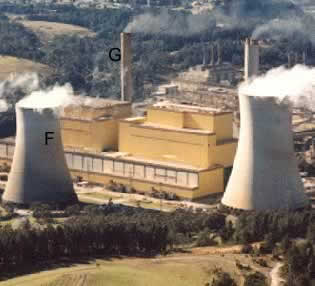
The workings of a coal fired power station are simple and straight forward. The animation above simplifies the process. Initially coal is pulverized (D) and burnt in a furnace (C). The heat energy released is used to heat water into super hot steam which is then used to turn turbines (B). The turbines drive the generators (A) which produce electricity.
The steam is then condensed and recycled.
The chimney labeled "F", known as a condensing tower, releases water vapour and is part of the recycling of steam. The chimney labeled "G" is attached to the furnace and releases carbon dioxide and ash.
The energy conversions that take place in a coal fired power plant are as follows.
Chemical potential energy, in the form of coal (Step D) => Heat energy (Step C)
=> Kinetic energy or mechanical energy (Step B) => Electrical energy (Step A).
Every time energy is converted from one form into another a great amount of it is lost during the conversion. The less energy conversion steps, therefore, the more efficient the production of electricity becomes.

A major difference between a nuclear power station and a coal fired power station is the way heat energy is produced to heat the water. Describe the difference between a nuclear power station and a coal fired power station.
Why are nuclear power stations considered as alternatives to coal fired power stations in the struggle to combat global warming?
What is the difference between a hydro-electric power station and a coal-fired power station?
Ultimately where does the energy for a coal fired power station come form? Click here for more information
Continue with energy conversion of a hydroelectric power station